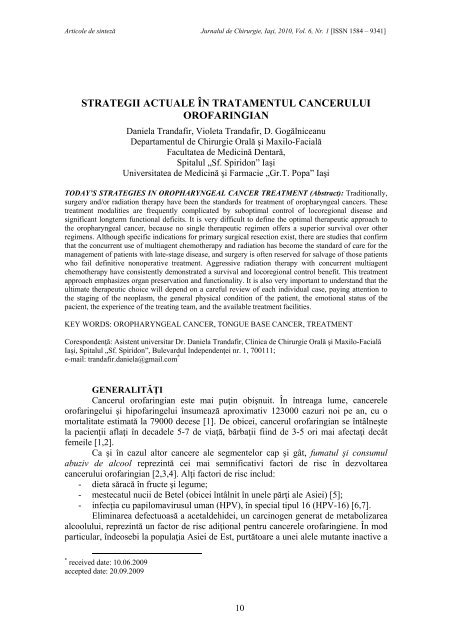Full text PDF (5 MB) - Jurnalul de Chirurgie
Full text PDF (5 MB) - Jurnalul de Chirurgie
Full text PDF (5 MB) - Jurnalul de Chirurgie
You also want an ePaper? Increase the reach of your titles
YUMPU automatically turns print PDFs into web optimized ePapers that Google loves.
Articole <strong>de</strong> sinteză <strong>Jurnalul</strong> <strong>de</strong> <strong>Chirurgie</strong>, Iaşi, 2010, Vol. 6, Nr. 1 [ISSN 1584 – 9341]<br />
STRATEGII ACTUALE ÎN TRATAMENTUL CANCERULUI<br />
OROFARINGIAN<br />
Daniela Trandafir, Violeta Trandafir, D. Gogălniceanu<br />
Departamentul <strong>de</strong> <strong>Chirurgie</strong> Orală şi Maxilo-Facială<br />
Facultatea <strong>de</strong> Medicină Dentară,<br />
Spitalul „Sf. Spiridon” Iaşi<br />
Universitatea <strong>de</strong> Medicină şi Farmacie „Gr.T. Popa” Iaşi<br />
TODAY’S STRATEGIES IN OROPHARYNGEAL CANCER TREATMENT (Abstract): Traditionally,<br />
surgery and/or radiation therapy have been the standards for treatment of oropharyngeal cancers. These<br />
treatment modalities are frequently complicated by suboptimal control of locoregional disease and<br />
significant longterm functional <strong>de</strong>ficits. It is very difficult to <strong>de</strong>fine the optimal therapeutic approach to<br />
the oropharyngeal cancer, because no single therapeutic regimen offers a superior survival over other<br />
regimens. Although specific indications for primary surgical resection exist, there are studies that confirm<br />
that the concurrent use of multiagent chemotherapy and radiation has become the standard of care for the<br />
management of patients with late-stage disease, and surgery is often reserved for salvage of those patients<br />
who fail <strong>de</strong>finitive nonoperative treatment. Aggressive radiation therapy with concurrent multiagent<br />
chemotherapy have consistently <strong>de</strong>monstrated a survival and locoregional control benefit. This treatment<br />
approach emphasizes organ preservation and functionality. It is also very important to un<strong>de</strong>rstand that the<br />
ultimate therapeutic choice will <strong>de</strong>pend on a careful review of each individual case, paying attention to<br />
the staging of the neoplasm, the general physical condition of the patient, the emotional status of the<br />
pacient, the experience of the treating team, and the available treatment facilities.<br />
KEY WORDS: OROPHARYNGEAL CANCER, TONGUE BASE CANCER, TREATMENT<br />
Corespon<strong>de</strong>nţă: Asistent universitar Dr. Daniela Trandafir, Clinica <strong>de</strong> <strong>Chirurgie</strong> Orală şi Maxilo-Facială<br />
Iaşi, Spitalul „Sf. Spiridon”, Bulevardul In<strong>de</strong>pen<strong>de</strong>nţei nr. 1, 700111;<br />
e-mail: trandafir.daniela@gmail.com *<br />
GENERALITĂŢI<br />
Cancerul orofaringian este mai puţin obişnuit. În întreaga lume, cancerele<br />
orofaringelui şi hipofaringelui însumează aproximativ 123000 cazuri noi pe an, cu o<br />
mortalitate estimată la 79000 <strong>de</strong>cese [1]. De obicei, cancerul orofaringian se întâlneşte<br />
la pacienţii aflaţi în <strong>de</strong>ca<strong>de</strong>le 5-7 <strong>de</strong> viaţă, bărbaţii fiind <strong>de</strong> 3-5 ori mai afectaţi <strong>de</strong>cât<br />
femeile [1,2].<br />
Ca şi în cazul altor cancere ale segmentelor cap şi gât, fumatul şi consumul<br />
abuziv <strong>de</strong> alcool reprezintă cei mai semnificativi factori <strong>de</strong> risc în <strong>de</strong>zvoltarea<br />
cancerului orofaringian [2,3,4]. Alţi factori <strong>de</strong> risc includ:<br />
- dieta săracă în fructe şi legume;<br />
- mestecatul nucii <strong>de</strong> Betel (obicei întâlnit în unele părţi ale Asiei) [5];<br />
- infecţia cu papilomavirusul uman (HPV), în special tipul 16 (HPV-16) [6,7].<br />
Eliminarea <strong>de</strong>fectuoasă a acetal<strong>de</strong>hi<strong>de</strong>i, un carcinogen generat <strong>de</strong> metabolizarea<br />
alcoolului, reprezintă un factor <strong>de</strong> risc adiţional pentru cancerele orofaringiene. În mod<br />
particular, în<strong>de</strong>osebi la populaţia Asiei <strong>de</strong> Est, purtătoare a unei alele mutante inactive a<br />
* received date: 10.06.2009<br />
accepted date: 20.09.2009<br />
10

















